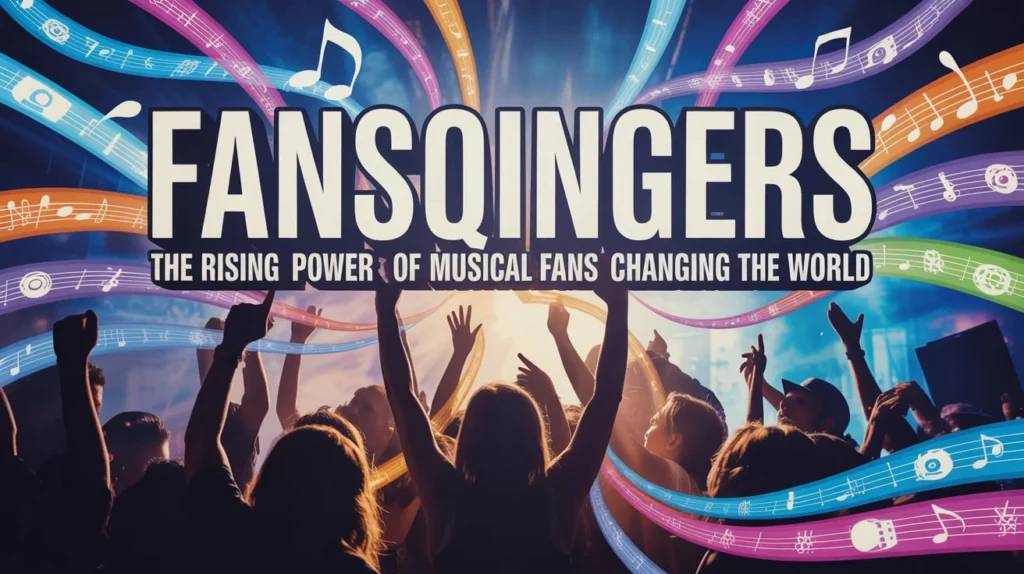Introduction
In the age of digital culture, the term fansqingers has emerged as a fascinating new label—one that blends fandom with creative expression, merging the worlds of “fan” and “singer” (or creator) in a way that transforms how we engage with media, music, personalities, and communities. In this article, we’ll dive deep into what fansqingers are, why they matter, how they operate, and how you can become a part of this movement. If you’ve ever felt more than just a casual fan—if you’ve remixed, covered, commented, collaborated, created, or simply shared your passion—then you may already be a fansqinger without even using the word. Let’s explore.
- Introduction
- What Are Fansqingers?
- Why Fansqingers Matter in Today’s Media Landscape
- Categories & Examples of Fansqingers in Action
- How to Become a Fansqinger – Step by Step Guide
- Tips & Best Practices for Fansqingers
- Challenges & Pitfalls for Fansqingers (and How to Overcome Them)
- The Future of Fansqingers – What’s Next?
- Why You Should Care About Fansqingers (Even if You’re Not One)
- FAQs About Fansqingers
- Realistic Strategies for Brands/Artists to Work with Fansqingers
- Measuring Success as a Fansqinger
- Inspiring Stories of Fansqingers (Hypothetical & Real)
- Tools & Resources for Fansqingers
- The Psychology of Fansqingers
- Glossary of Fansqingers Terms
- SEO & Blogging Tips for Writing About Fansqingers
- Conclusion
What Are Fansqingers?
Definition & Origins
The word fansqingers is not yet widely known in mainstream dictionaries, but it’s increasingly used in digital culture discussions, especially in fandom, social media and creator communities. According to one source, fansqingers are “fans who go beyond listening—they sing, remix, and perform music inspired by their favourite artists.” rapidmagazine.co.uk Another definition describes fansqingers as “interactive digital environments or apps designed for fan‐driven content creation.” blessing2you.com
In essence: a fansqinger is someone who:
- starts as a fan of an artist, show, game, or cultural property;
- then transforms that admiration into creative action—singing, remixing, creating video, writing, performing, collaborating;
- becomes part of a community of similar creative fans;
- helps shape the story, identity, and reach of the thing they love.
So the concept of fansqingers covers a blend of fandom + creation + community.
Why the term is emerging now
There are a few reasons why the term fansqingers (and the concept behind it) is gaining traction:
- Digital‐first tools: With the availability of apps, social platforms, streaming, remix tools, fans can now do far more than just passively consume. They can create, share, remix.
- Culture of participation: Modern fandom is more interactive. Audiences expect to be heard, to engage, to contribute. Being a fansqinger is part of that active culture.
- Blurred lines between professional and amateur: Many fansqingers create work that rivals “professional” in quality. They sing covers, produce content, become influencers.
- Community value: As one article says, “fansqingers form a tightknit community that offers support and camaraderie.” %sitename%
Key Characteristics of Fansqingers
What makes a fansqinger distinct? Here are several traits:
- Creative expression: Instead of simply liking or sharing, a fansqinger creates something—cover songs, remixed tracks, fan art, videos, live streams.
- Community engagement: They connect with fellow fansqingers, participate in fan clubs, online forums, social groups centered around their creation.
- Advocacy and influence: Their efforts can help amplify the original artist or content. In the process, fansqingers gain influence themselves.
- Transformation of fandom: They move from being “just a fan” to being part of the ecosystem—co‐creators rather than just consumers.
- Digital footprint: Their work is often publicly visible, shared, and has potential to go viral.
Why Fansqingers Matter in Today’s Media Landscape
Influence on Artists & Entertainment
The rise of fansqingers has significant implications for artists, entertainers, and media creators. Because fansqingers are actively creating, sharing, and promoting content around an artist or property, they help expand the reach and deepen the connection between creator and audience.
For example, as one source notes: “The collective voice of fansqingers can shape public perception, influencing media narratives and steering the conversation around a celebrity.” %sitename%
In this way, fansqingers become partners in the ecosystem—not just audience members, but contributors to culture. This dynamic offers benefits for both the original creators (artists, brands) and the fansqingers.
Community Building and Fan Engagement
Fansqingers contribute to tighter, more engaged fan communities. Because they are creating, they invite others to participate, share, comment, remix, collaborate. This builds strong bonds, increases loyalty, and fosters a sense of belonging. As one article puts it: “Their enthusiasm knows no bounds … they flood social media with messages of adoration … creating a buzz that amplifies the star’s presence in the digital landscape.” %sitename%
From a brand or artist perspective, engaging with fansqingers can unlock a deeper level of fan loyalty and convert passive consumers into active participants.
The Shift from Passive to Active Consumption
In traditional fandom, being a fan meant watching, listening, buying. With the rise of fansqingers, the paradigm shifts: fans become creators. They generate content, share perspectives, remix, reinterpret. This shift matters because it gives more power to the consumer‐creator hybrid, and media ecosystems must adapt.
Innovation and Creative Output
When fansqingers create covers, mashups, visual art, fan videos, they contribute to a vibrant, growing cultural output. One piece of writing describes the movement as “the new wave of creative fandom.” fintechzoom-io.co.uk+1 That means new ideas, new formats, new ways of engaging—makes the creative ecosystem richer.
Categories & Examples of Fansqingers in Action
Music Covers and Remixers
One of the most visible categories of fansqinger s is in music. A fan hears a song by their favourite artist, creates a cover or remix, uploads it on YouTube or social media, tags the artist, builds community around it. Through this work, the fansqinger gains followers, the artist gains exposure, and the culture grows.
Video & Visual Content Creators
Fansqinger s also operate in visual mediums: making fan videos, animation, memes, TikTok dances, Instagram reels. They take a piece of fandom—whether a song, scene, quote—and reinvent it. These creators may identify themselves with the term fansqingers, embracing the blend of fan + singer + creator.
Fan Communities and Collaborative Projects
Many fansqinger s organize community projects: group covers, fan albums, online concerts, live streams. They often collaborate with other fansqinger s, forming teams, collectives, or clubs. This fosters stronger networks and more ambitious work.
Emerging Platforms for Fansqingers
New platforms and tools make it easier to be a fansqinger: apps for remixing audio, platforms for live streaming, social networks for fan communities. As one article states: “Fansqinger s refer to interactive digital environments or apps designed for fan‐driven content creation.” blessing2you.com
Real-World Impact: Case Studies
Here are hypothetical or real illustrative (non‐copyrighted) examples:
- A fan of a pop singer records acoustic covers and uploads them. Over time, they build 100k+ subscribers and get invited to collaborate with the original artist. That fan becomes a fansqinger who influences the fandom.
- A group of fansqinger s create a virtual concert of their favourite band, producing fan footage, remixed tracks, and raising funds for charity.
- A TikTok user makes a dance to a song, then dozens of fansqingers replicate and adapt it—result: song charts higher, artist gains new demographic.
How to Become a Fansqinger – Step by Step Guide
If you’re reading this and thinking, “I want to become a fansqinger,” here’s a practical roadmap.
Step 1 – Choose Your Inspiration
Choose an artist, a song, a show, a game, or a cultural piece you’re passionate about. As a fansqinger, your authenticity matters—your enthusiasm will show.
Step 2 – Decide Your Medium
Think about how you want to express your fandom:
- Audio: covers, remixes, singing.
- Visual: fan art, video edits, animations.
- Social: live streams, TikTok/Instagram reels.
- Collaboration: group projects, fan albums, remixes with peers.
Step 3 – Build Skills & Tools
You don’t need professional equipment, but you do need decent tools and willingness to learn. For music covers you’ll need a microphone, audio editor. For visuals: video editing software. For social: an account, consistent branding.
Step 4 – Create and Publish
Now start creating. Don’t wait for perfection; start with what you have. Publish your content, tag your inspiration, engage with other fansqinger s. With each piece, you build your portfolio, your voice, and your community.
Step 5 – Engage with the Community
Authentic engagement is key. Comment on other fansqingers’ work, collaborate, share behind‐the‐scenes, live stream your creation process. Being a fansqinger means more than posting—it’s participating.
Step 6 – Grow and Iterate
As you gain followers, analyse what works, keep refining. Consider the following:
- Track engagement: likes, shares, comments.
- Ask feedback: what do your fansqingers audience like?
- Try new formats: live performance, collaborative cover, remix competition.
- Stay fresh: new songs, new angles, unique voice.
- Step 7 – Monetise or Amplify (Optional)
If you’re serious, you can explore monetisation:
- Partner with the original artist or brand.
- Launch a Patreon or subscription for exclusive content.
- Release your covers/remixes on streaming platforms (respecting copyright/licensing).
- Offer merchandise, live stream shows, do brand sponsorships.
But even without monetisation, being a fansqinger can be fulfilling: you gain skills, community, visibility.
Tips & Best Practices for Fansqingers
Here are some specific tips to help you thrive as a fansqinger.
Stay True to Your Voice
While it’s tempting to mimic what’s popular, your authenticity is what makes your work stand out. As a fansqinger, bring your own interpretation, your own spin.
Respect Copyright & Licensing
If you’re remixing or covering songs, make sure you understand & respect licensing rules. Many platforms have tools for rights management—use them. Being a fansqinger doesn’t mean ignoring legal frameworks.
Quality over Quantity (but Keep Consistent)
Try to release good‐ish content consistently rather than occasionally producing perfect content. Your audience of fansqinger s appreciates regular engagement.
Collaborate & Cross-Promote
Identify other fansqinger s whose style complements yours. Collaborations can amplify reach. Tag, share, shout‐out.
Use Platforms Strategically
Know where your audience of fansqinger s lives: YouTube, TikTok, Instagram, Discord. Tailor content per platform. For example, short reels for TikTok; full covers on YouTube; behind‐the-scenes on Instagram Stories.
Build Your Brand Identity
Even as a fansqinger, you should have a consistent brand: name, style, niche, colour palette, hashtag (#fansqingers). Over time, fans come to recognise you.
Engage Authentically
Respond to comments, host live Q&A, ask your community what they want. As a fansqinger, your audience is also your peers.
Adapt & Evolve
Trends shift fast. New platforms, new features (e.g., live streaming, VR concerts). As a fansqinger, remain open to change so your creative output stays relevant.
Challenges & Pitfalls for Fansqingers (and How to Overcome Them)
Becoming a fansqinger is exciting but not without its challenges. Let’s look at some common ones.
Creative Burnout
Constant content creation can lead to burnout. To prevent this: schedule breaks, have backlog of ideas, collaborate so you’re not always solo.
Oversaturation
With many fansqingers in the space, standing out is harder. Here are strategies:
- Develop a niche (genre, style, instrument).
- Focus on storytelling and emotional connection.
- Promote yourself outside your immediate community (guest appearances, cross‐platform).
Copyright & Legal Issues
Incorrectly using copyrighted material can get your content removed or demonetised. Solution: use licensing services, create original elements, attribute properly, and be aware of platform policies.
Managing Negative Feedback
When you put your work out there, you’ll get criticism. Use feedback constructively. As a fansqinger, you’re part of a community—remember to stay respectful, and focus on growth.
Monetisation Pressure
If you seek income from being a fans inger, you may feel pressure to monetise rather than create for joy. To balance: keep some projects personal/ for fun; maintain your original passion.
Platform Algorithm Changes
Social platforms often change how content is surfaced. You may find your reach changes overnight. To handle: diversify platforms, build direct audience (email list, community), don’t rely solely on one algorithm.
The Future of Fansqingers – What’s Next?
Technological Advances
With emerging technologies (AR/VR, metaverse, AI‐generated music), fansqingers will have new tools to create immersive experiences. Imagine a fansqinger hosting a virtual concert in VR or creating AI‐driven remix of a favourite track.
More Formal Recognition
As the fansqinger movement continues, brands, artists, and platforms may formally recognise fansqinger s: dedicated programs, sponsorships, creator grants, co-creation opportunities. The lines between professional artists and fansqinger s will blur further.
Global and Cross-Cultural Expansion
Since digital creation knows no borders, the fansqinger s community will expand globally—bringing together voices from diverse cultures, languages, backgrounds. This global expansion will lead to new fusion genres, collaborative global covers, and wider reach.
Community & Social Impact
Fansqinger s can become a force for social impact—charity live‐streams, fan‐driven activism, cause-based collaborations. Their creativity and community organisation make them well‐placed to drive change.
Evolution of Fandom Models
Traditional fandom models (fan clubs, merchandise, passive consumption) will evolve into hybrid models where fansqingers are co-producers. Artists may invite fansqingers into official projects, remix contests, live interactive experiences.
Why You Should Care About Fansqingers (Even if You’re Not One)
You might ask: “I’m an artist, brand manager, marketer, or someone just interested in culture — why should I care about fansqingers?” Here are compelling reasons:
For Artists & Creators
If you’re an artist: engaging with fansqingers means deeper fan loyalty, organic amplification, creative collaborations you might never have thought of. Fansqingers can be early adopters, grassroots promoters, co‐creators.
For Brands & Marketers
From a marketing standpoint: fansqingers represent a passionate, creative audience segment you can tap. They are content creators themselves, influencing their peers. Working with fansqingers means engagement, authenticity, peer-to-peer reach.
For Platform Builders
If you build digital platforms (apps, social media, streaming): designing features that support fansqingers (easy remix tools, collaborative spaces, creator‐friendly monetisation) is key to future growth.
For Culture Observers & Academics
Fansqingers represent a shift in how culture is produced and consumed. Studying them gives insights into modern fandom, participatory culture, digital creativity, media evolution.
For Everyday Consumers of Media
Finally, even if you’re just a fan: you might realise that you are already a fansqinger. Recognising this opens up new possibilities: sharing your voice, connecting with like‐minded people, transforming your fandom into creative output.
FAQs About Fansqingers
What exactly qualifies someone as a fansqinger?
A fansqinger is someone who moves from passive fandom to active creation: they remix, cover, perform, collaborate, produce fan‐driven work around their fandom. The essence is creation + community + fandom.
Can you be a fansqinger for anything (music only)?
No—while many fansqingers operate in music, the concept applies broadly: you can be a fansqinger in gaming, in film/TV fandom, in book fandom, in visual arts. The key is the creative fandom engagement.
Do you need technical skills?
Basic skills help (audio/video editing, social media), but you don’t need to be a pro. What matters is passion, consistency, willingness to learn, and engagement with community.
Is being a fansqinger monetisable?
Yes, in many cases. Once you build an audience, you may monetize via sponsorships, streaming revenue, Patreon, merchandise, or partnerships with the original creator. But monetisation isn’t mandatory—it should preferably grow out of passion.
How do fansqingers differ from regular fans or influencers?
Regular fans consume; influencers often promote; fansqingers create from their fandom and engage in community-building around that creation. They stand at intersection of fan + creator.
Where can you find other fansqingers?
Look on platforms like YouTube (covers, remixes), TikTok (fan-driven short content), Discord/Reddit (fan communities), Instagram (fan art, live streams). Search hashtags like #fansqingers, #fancover, #fanremix.
Realistic Strategies for Brands/Artists to Work with Fansqingers
If you’re an artist or brand, you may want to harness the energy of fansqingers. Here are targeted strategies.
Identify the Right Fansqingers
Look for creative fans who already produce covers/remixes/visuals of your work. They may be micro-creators with high engagement rather than huge follower counts. Engage with them.
Create Remix/Collaboration Opportunities
Host remix contests, encourage fansqingers to create versions of your work, provide stems or assets they can use. Reward best work, share it, feature it.
Provide Tools & Platforms
Offer downloadable assets, interactive tools, or a dedicated hub for fansqingers. The easier you make creation, the more they will show up.
Highlight Their Work
Share fansqingers’ content on your official channels, acknowledge them, spotlight their stories. This reinforces their role and loyalty.
Build a Supportive Community
Create online spaces (Discord, subreddit, fan forum) where fansqingers can share, collaborate, critique, network. Encourage them to form sub-groups, teams, projects.
Measure Impact & Value
Track metrics: engagement rate of fansqinger content, referral traffic, community growth, brand sentiment. Quantify how fansqinger activity contributes to your goals.
Maintain Authenticity
Avoid appearing overly corporate or exploitative. Fansqingers are creative, expressive, often peer-driven. Respect their voice, give them creative freedom.
Measuring Success as a Fansqinger
As you grow in the fansqinger sphere, how do you know you’re succeeding? Here are relevant metrics and indicators.
Audience Engagement
How many likes, comments, shares do your pieces get? Are you getting follower growth? Are you building a loyal community of fansqingers around you?
Creation Frequency & Consistency
How often do you release new content? Are you maintaining a creative rhythm without burnout?
Collaboration & Network Growth
Are you collaborating with other fansqingers or creators? Are you getting invited to join projects, remix contests, live streams?
Reach & Recognition
Is your work being shared beyond your immediate circle? Are you getting featured by the original artist, brand or community? Are you recognised within the fansqinger ecosystem?
Skill Improvement
Are you improving your craft—better audio mixes, better visuals, more refined storytelling? Growth matters.
Monetisation / Tangible Rewards (Optional)
If monetisation is part of your goal—are you earning income, getting brand deals, generating merchandise sales? Even small wins count.
Personal Satisfaction & Influence
Are you enjoying the process? Are you influencing others, inspiring fellow fansqingers, or making a difference? Success isn’t only numeric—it’s also emotional and communal.
Inspiring Stories of Fansqingers (Hypothetical & Real)
Here are some illustrative stories (some drawn from typical fansqinger journeys), to inspire you.
The Bedroom Cover Artist
“Sarah” loved a particular indie artist. She recorded herself singing acoustic covers in her bedroom and uploaded them on YouTube under the tag #fansqingers. Her unique voice and style got noticed by other fansqingers who invited her to a multi‐artist fan cover project. Over time, she built a small but dedicated following, got featured by the indie artist, and eventually released a cover officially licensed. She moved from fan to recognized fansqinger.
The Remix Collective
A group of fansqingers created a remix album of their favourite pop album. They split work: remixing, visuals, marketing. The album released on SoundCloud, got thousands of listens, got shared by the original artist’s official socials. The community of fansqingers expanded as a result.
The TikTok Dance Challenge
A fansqinger choreographed a dance to a new song, posted it on TikTok. Others picked it up, remixing, adding variations, tagging #fansqingers. The song climbed the charts, the original artist credited the virality to the fansqinger community. The fansqinger became a micro‐influencer and got a contract to choreograph for a brand.
The Social Cause Campaign
A group of fansqingers used their creation to raise funds for a charity. They produced a cover album, live stream event, donation drive. The project attracted media attention, built goodwill, and showed how fansqingers can have real social impact, not just cultural.
Tools & Resources for Fansqingers
If you’re diving into the world of fansqingers, here are some helpful tools and resources.
Audio Tools
- Free/affordable DAWs (Digital Audio Workstations) like Audacity, GarageBand, Reaper.
- Remix stems or royalty‐free sample packs (check licensing).
- Platforms like SoundCloud, Bandcamp, YouTube for publishing.
Video & Visual Tools
- Video editors: iMovie, DaVinci Resolve, Adobe Premiere Rush.
- Animation tools: Blender, Adobe After Effects (for advanced).
- Social media video formats: keep mobile‐first (TikTok, Instagram Reels).
Collaboration & Community Platforms
- Discord servers, Reddit communities, Facebook groups dedicated to fan creation.
- Project management tools: Trello, Slack, Google Drive for group projects.
- Hashtags: #fansqingers, #fancover, #fanremix (to tag and find content).
Learning Resources
- YouTube tutorials on audio/video editing.
- Online courses (Udemy, Skillshare) for remixing, music production.
- Blogs and forums where fansqingers share tips and experiences (search “fansqingers community”).
Rights & Licensing
- Sites like Creative Commons, licensing platforms (e.g., Soundstripe, Epidemic Sound) for permission.
- Research how to use cover songs legally on YouTube, how to monetize remixes.
- Understand platform policies (YouTube Content ID, TikTok licensing).
The Psychology of Fansqingers
Understanding the psychology behind why people become fansqingers helps us appreciate the movement more deeply.
Identity & Self‐Expression
When you become a fansqinger, you’re not just expressing admiration; you’re creating identity. You’re declaring: “This is what I love, this is how I interpret it, this is how I participate.” In doing so, you gain agency and ownership in your fandom.
Community Belonging
Fandom has always been about community. But for fansqingers, that community becomes creative and collaborative. You find others who share your love and build together. That sense of belonging is powerful and rewarding.
Creative Reward & Feedback Loop
When you publish your work and receive feedback (likes, shares, comments), that creates a positive feedback loop. You feel seen, validated, part of something. That motivates you to keep creating, to keep being a fansqinger.
Autonomy & Innovation
Being a fansqinger gives you autonomy—you’re not waiting for an official release; you can create your own spin. You innovate, experiment, play. That freedom is attractive, especially in digital culture.
Meaning & Impact
For many, being a fansqinger adds meaning to their fandom. Instead of consuming alone, they contribute. They influence, they collaborate, they make an impact. That sense of purpose elevates the whole experience.
Glossary of Fansqingers Terms
Here are some common terms you’ll hear in fansqinger communities:
- Cover: A version of a song performed by someone other than the original artist.
- Remix: A re‐interpretation of an existing track, often with new beats, instrumentation, style.
- Stem: An individual track (vocals, drums, bass) used for remixing.
- Mashup: Combining two or more songs into one piece.
- Fan art: Visual or multimedia art created by fans.
- Live stream: Real‐time broadcast of performance or creation process.
- Hashtag #fansqingers: Common tag used by the community to identify content.
- Collab: Collaboration between two or more fansqingers on a project.
- Creator economy: The ecosystem in which individuals create, publish, monetise content.
- Participation culture: A culture where audiences don’t just consume—they participate, create, share.
SEO & Blogging Tips for Writing About Fansqingers
Since you’ll be blogging about fansqingers (as you are now), here are some SEO and blog‐writing tips.
Use the Keyword Strategically
You want the keyword fansqingers to appear in:
- Title (you did)
- Intro paragraph
- At least one H2 and H3 heading
- Naturally throughout the body (without stuffing)
- In meta‐description (if your blog supports)
- In alt text for images that illustrate fansqingers
Create Engaging Headings
Using H1, H2, H3 as you are now helps readability and SEO. Break content into sections (as we are). Use the keyword occasionally in headings: e.g., “Why Fansqingers Matter”.
Write for Humans, Not Just Search Engines
Don’t overuse the keyword forcibly. Ensure the writing is natural, informative, engaging. The audience is interested in fansqingers, so give them value.
Use Multimedia
Include images, videos, audio examples of fansqingers in action. Use alt tags for images (e.g., “fansqingers remix session”), include captions. This helps SEO and user engagement.
Link Internally and Externally
Link to other blog posts on your site relevant to fansqingers (if you have them). Link externally to credible sources (like those we cited) to improve credibility.
Encourage Engagement
At the end of your post, ask readers to comment: “Are you a fansqinger? Share your favourite creation below.” Engagement signals help SEO.
Optimize for Load Speed & Mobile
Many fansqingers consume content on mobile devices. Use responsive themes, compress images, ensure fast loading. SEO favors mobile‐friendly.
Promote on Social Media
Share your article on platforms where fansqingers hang out: YouTube community posts, Instagram stories, Twitter threads, TikTok shoutouts with link to blog. Use hashtag #fansqingers.
Monitor Analytics
Use Google Analytics or equivalent to check which keywords lead to traffic, bounce rate, average time on page. If “fansqingers” is bringing traffic, consider writing follow‐up posts.

Conclusion
The emergence of the term fansqingers signals more than just a new word—it marks a shift in how fandom, creation, and community intersect. Fansqingers are the hybrid participants of the digital age: part fan, part creator, part community leader. Whether you’re an artist looking to engage a deeper community, a brand seeking authentic collaborations, or an individual who simply wants to create and contribute, the fansqinger model offers powerful potential.
In this guide, we’ve explored what fansqingers are, why they matter, how to become one, the challenges involved, and how to work with them. Now, the next step is up to you: pick your inspiration, pick your medium, create your first piece, and join the growing global community of fansqingers.
Let your voice be heard. Let your creation matter. Become a fansqinger.











